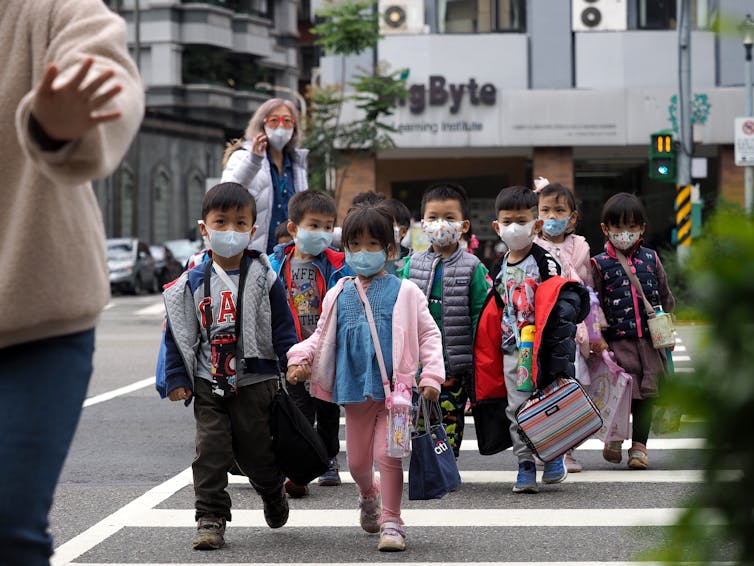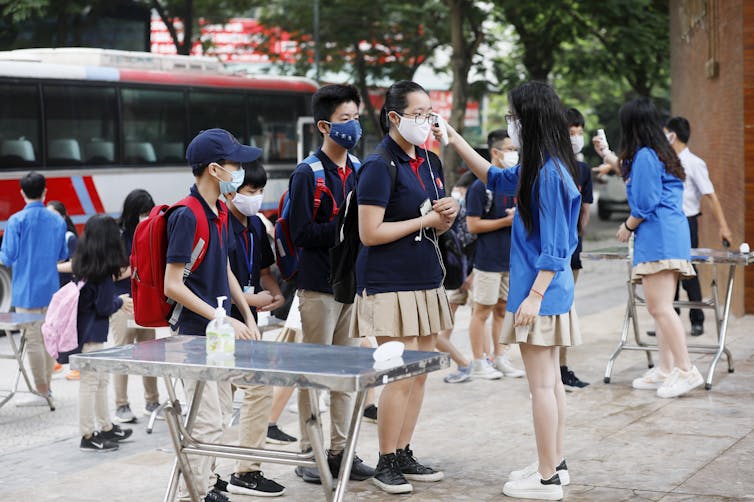UK Education Secretary Gavin Williamson said he wants nothing more than to see schools back up and running following their closure during the coronavirus lockdown. But he insists he cannot yet give a date for that to happen since there were “no plans” to open schools over the summer while the UK awaits “scientific advice”.
In contrast, Denmark began reopening schools in April. Germany and France will reopen progressively after May 4 and 11, respectively. Different contexts, different decisions in Europe.
As the director general of the World Health Organization said on March 12, the management of the COVID-19 pandemic is a question of “finding a delicate balance between health protection, the prevention of economic and social risks and respect for human rights”. The reopening of schools is seen as a symbolic and practical herald of recovery. These are important political decisions and must be based on robust evidence.
School closures affect all students and play a role in amplifying inequalities. The school is both a living environment for students and staff and an education setting. Besides the impact on learning and the consequences for the mental health of students, closure deprives the most vulnerable students of school meals and support from education, health and social staff.
Confinement also aggravates economic problems for families, which can lead to increases in episodes of domestic violence, child abuse and neglect. Preliminary neuroscience research suggests that the brains of young people need to be wired for social connection during childhood and adolescence in order to maintain health and wellbeing. Depriving children of social stimuli during this critical period of development can have long-term consequences.
What’s more, a recent literature review showed that, in previous epidemics, transmission in schools was very low or absent. Modelling studies for the COVID-19 pandemic predict that school closures would prevent only 2-4% of deaths – far less than other social distancing interventions. This suggests that reopening schools could be the right option, if combined with barrier use, social distancing and a robust programme of testing, contact tracing and isolation.
Scientific knowledge alone is not enough to guide policies and practices; it is necessary to link it with other sources of knowledge – particularly from the experience of other countries and the knowledge of professionals in the field. Convergence of data is needed to identify what is desirable and achievable.
Learning from countries that have reopened schools
Even if comparisons are limited by cultural and social differences, learning from the successes of countries that have kept schools running is helpful.
Taiwan, for example, has been widely recognised for successfully managing the crisis. The number of cases has remained very limited, largely because institutions have learned from past epidemics and were prepared. Testing the close contacts of people who were infected and then quarantining them for 14 days at home was a primary strategy for containment.

Differentiated school closure rules were also enacted at the national level. If one teacher or student is affected, they are quarantined for 14 days at home. If two or more teachers or students have a confirmed infection, the school is closed. And if a third of schools in a district or city have to take this measure, then all schools in the area are closed too.
In classrooms and canteens, students are separated from each other by plastic partitions between desks, systematic temperature checks are carried out and masks are compulsory. A survey of secondary school students showed the majority (70%) considered that these measures had not affected their learning.
Making it work
The challenge is to design an education system that delivers effective learning while protecting staff and students. Available data allow us to identify four benchmarks that can guide both political decisions and the action of parents, students and professionals.
1. A differentiated system
The level of epidemic risk and the vulnerability of students differs across regions and even from one school to another. That means it won’t be possible to reopen schools the same way everywhere.
A framework for decisions should be produced at the national level, but elected representatives and education professionals should be empowered to make decisions at the local level. This should be done in extensive consultation with education managers, administrators, teachers, families, students, health and social workers as well as technical support experts and those working in safety and transport. The aim must be to create a strategy that works within the local context.
Professionals need training, intersectoral health and education support and high-quality resources. The plan must include public health risk assessments of services outside direct school control – such as public transport used by children and parents.
Finally, because of the lower learning autonomy of young children, and the early onset of social and educational inequalities, priority should be given – as in Denmark, France and Germany – to primary school reopening before secondary schools.
2. Organising to protect students and staff
Research confirms the value of social distancing combined with frequent hand washing or sanitiser use. Mask-wearing remains a controversial issue, although a recent review recommends widespread adoption in line with the “precautionary principle” when scientific data remain elusive. The mask offers limited protection, but it is a visual reminder and could provide a “behavioural boost”. A robust reopening plan must include all these hygiene measures.
The number of students present simultaneously in different spaces can be reduced by specifying methods of circulation in the establishment. Classrooms can be reorganised to increase the space between students and breaks and lunchtimes can be staggered. If teachers move between classrooms instead of students, circulation around buildings can be reduced. School weeks could also be shortened and different groups of students can attend on different days throughout the week. School transport will need reorganisation.
3. A hybrid approach
The lockdown period has led to the exploration of new teaching methods, such as online learning. In countries where these changes have been studied, a large majority of teachers and parents have adapted well to distance teaching and learning, but a minority face significant difficulties.
Specific arrangements will be needed for students who need more support. In the UK, the launch of a scheme to supply laptops and routers to disadvantaged students during lockdown highlights the fact that some homes lack the equipment, quiet space and broadband connectivity students need.
Given that it will most likely be necessary to reorganise school and home attendance times, there is already a need to prepare for hybrid teaching arrangements. That will mean thinking more often about the individual needs of pupils to help reduce inequalities.
4. Redefining our vision of the epidemic
Absenteeism of both students and professionals can be very high during epidemics due to both illness and voluntary withdrawal. Everyone, therefore, needs to be empowered to understand why schools are reopened even if the “war” against the virus is not won. They need to be helped to develop a more operational vision of the epidemic for their own ongoing daily lives.
The epidemics of Sars, Mers, HIV/AIDS and Ebola disease were controlled mainly by screening and population-based approaches to protection. This calls for the development of citizen skills and personal responsibility. To understand how to live with the virus, it seems important to help everyone to understand that a new balance will be established – not by the virus disappearing, but by limiting its transmission.

When classes reopen, it will be essential for students to reinforce their knowledge of microorganisms (and not only viruses) and to have a more ecological vision of the relationship between microbes and everyday health. They will need to work on media literacy and critical thinking. Existing curriculum materials such as the EU “e-bug” series may be helpful in this regard.
An evidence and practice-based re-opening
Drawing on all available research and experiential global evidence can not only help to implement the most suitable solutions – it can also empower the entire population to understand and act effectively within the confines of the present situation.
It will be necessary to review ways of working, strengthen work between sectors that operate around schools, consolidate knowledge from various sources, and develop decision-making at the regional and local level. Systematic monitoring and dedicated research are also needed to underpin future responses that limit education disruption and promote health for all.
Thanks to Min Chien Tsai from Fu jen University, Taipei and Valérie Ivassenko from the UNESCO Chair and WHO Collaborating Centre in Global Health & Education, Clermont Auvergne, France.
"urgent" - Google News
May 05, 2020 at 07:57PM
https://ift.tt/3dhVKpB
Coronavirus: there is an urgent need to re-open schools – this is how we make it happen - The Conversation UK
"urgent" - Google News
https://ift.tt/2ya063o
https://ift.tt/3d7MC6X
urgent
Bagikan Berita Ini














0 Response to "Coronavirus: there is an urgent need to re-open schools – this is how we make it happen - The Conversation UK"
Post a Comment